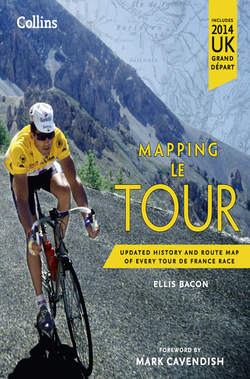Читать книгу Mapping Le Tour: The unofficial history of all 100 Tour de France races - Ellis Bacon - Страница 37
Оглавление1933
27th Edition
| Start: Paris, France, on 27 JuneFinish: Paris, France, on 23 July | |
| Total distance: 4396 km (2732 miles)Longest stage: 293 km (182 miles) | |
| Highest point:Col du Galibier: 2556 m (8386 ft)Mountain stages: 11 | |
| Starters: 80Finishers: 40 | |
| Winning time: 147 h 51’ 37”Average speed: 29.732 kph (18.475 mph) | |
| 1. Georges Speicher (Fra)2. Learco Guerra (Ita) at 4’ 01”3. Giuseppe Martano (Ita) at 5’ 08” | |
| Mountains: Vicente Trueba (Spa) |
At last – a clockwise Tour, for the first time since 1912. While the riders could ‘unwind’ after two decades of dizziness caused by following what had become a very samey anti-clockwise route around the edge of France, the watching public, too, must have appreciated the change of direction.
The dizzy heights of the race’s mountain climbs continued to capture the imagination as well, and 1933 was the first year that the organisers introduced an official grand prix de la montagne – the climber’s prize that would later use that garish white and red polka-dot jersey to identify the leader in the competition. That wouldn’t come until 1975.
Vicente Trueba – ‘The Torrelavega Flea’, hailing from the same Cantabrian town as Óscar Freire, who won Spain’s first, and only, green jersey in 2008 – hoovered up the big points available on most of the climbs in both the Alps and then the Pyrenees, including topping the Galibier and the Lautaret on stage 7, the Peyresourde and the Aspin on stage 17, and the Tourmalet and the Aubisque on stage 18, all at the head of the race.
Over in the French camp, both defending champion André Leducq and 1931 winner Antonin Magne were back, helping to make up a very strong team, but it was another member of the squad, 26-year-old Georges Speicher, who came to life in the Alps, winning two stages, and then won a third en route to Marseille to take the yellow jersey, which his team ably helped him defend all the way to Paris.
The race literally had a new direction, the French were still winning, and the race was more popular than ever, continuing to help shift copies of L’Auto, as had been the intention since the outset way back in 1903.
Spaniard Vicente Trueba conquered the Alps and Pyrenees, becoming the first rider to claim the grand prix de la montagne crown
